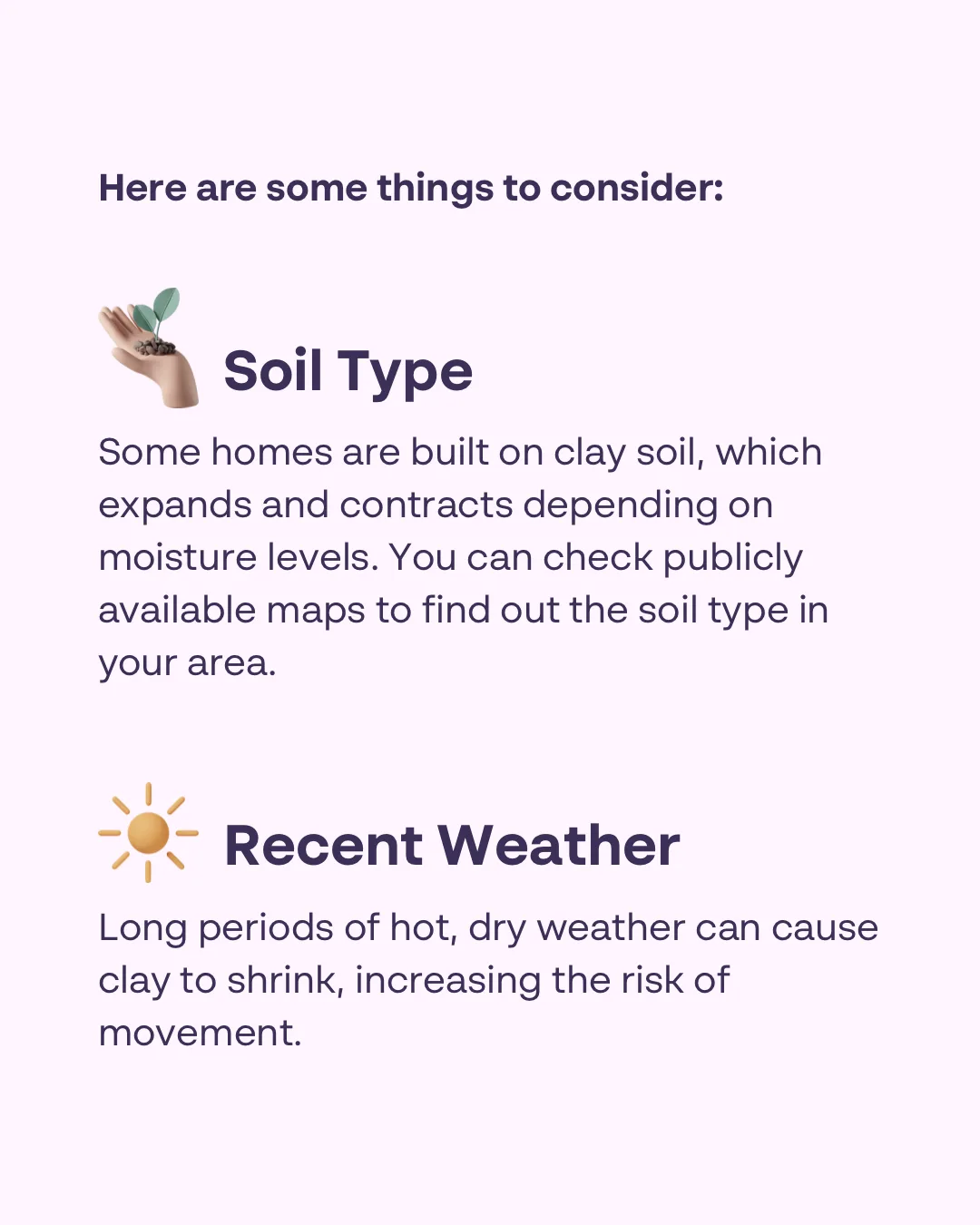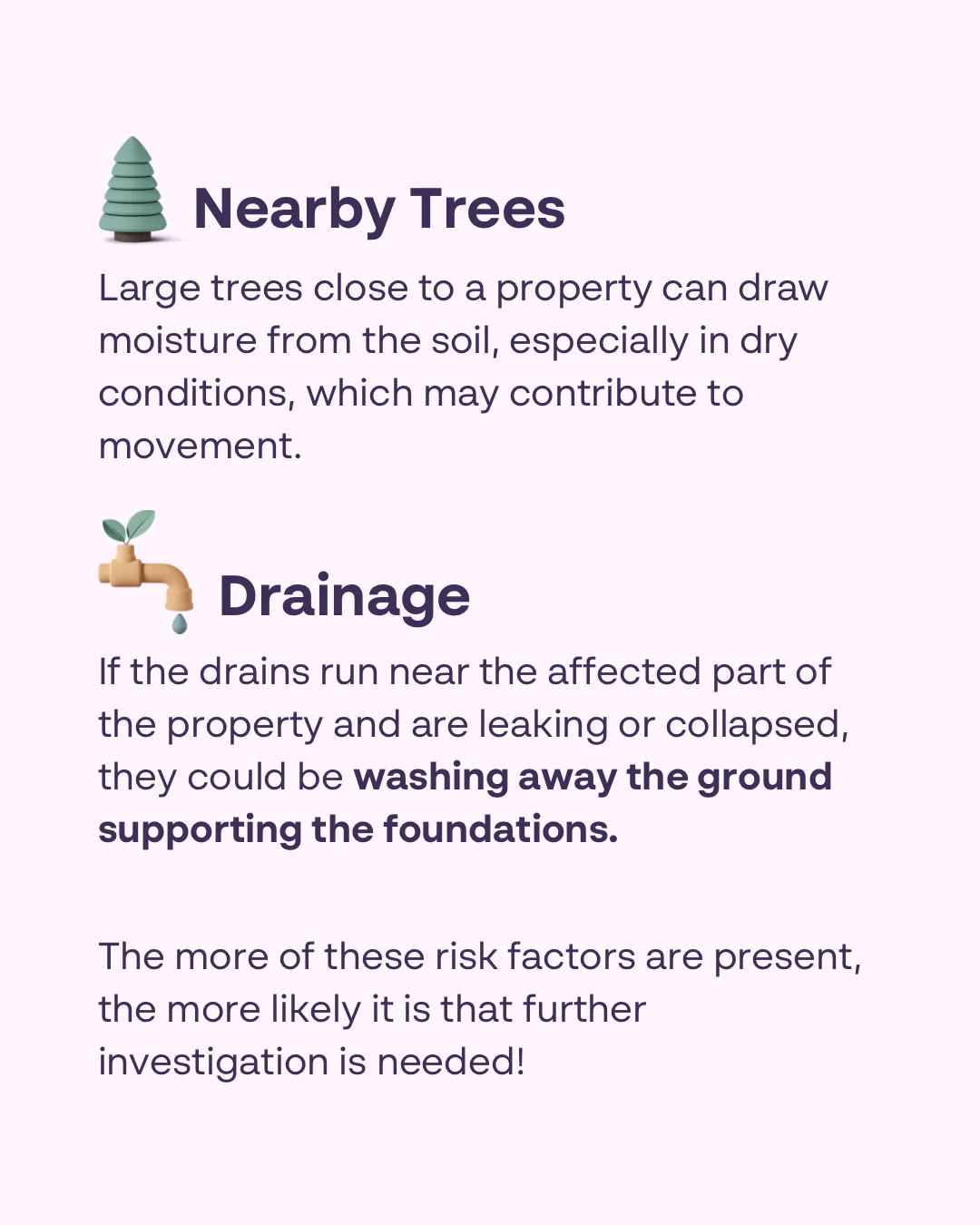Many cracks in buildings are cosmetic rather than structural. They often result from minor shrinkage, settlement, or surface movement. But others may indicate a deeper issue. The challenge is knowing which is which, and that is where proper assessment matters.
Subsidence is when the ground beneath a building sinks, usually in an uneven way. That movement reduces the support beneath parts of the foundation, which causes cracks and stress in the walls, floors, and structure above. Ground heave is the opposite. It happens when the ground swells and pushes part of the building upwards. The effects can be just as serious, even though the cause is reversed.
In the UK, subsidence is most often linked to shrinkable clay soils. These soils expand when wet and shrink when they dry out. If there are trees nearby, the root system can draw extra moisture from the ground, especially in dry weather. That speeds up the shrinkage. If this happens beneath a building, it can lead to downward movement of part of the structure.
Heave, on the other hand, is what happens when that same soil starts to rehydrate. A typical example is the removal of a large tree. While the tree is alive, it draws moisture from the soil. Once it is cut down, the soil starts absorbing water again. This expansion can push the ground upwards. In clay, that swelling can produce enough pressure to lift sections of the building or cause bulging and cracking in walls.
Drainage also plays a role. Leaking underground drains can soften or wash away supporting soil and reduce its ability to bear loads. This is particularly relevant in sandy or non-cohesive soils, where water movement can cause the ground to shift or erode. In clay, the moisture can also trigger shrinkage or swelling, depending on the conditions. So while water issues affect different soils in different ways, the result is often the same: movement.
We strongly recommend a full CCTV drainage survey of a property where you suspect foundation movement. Even if failed drains were not the original cause, when foundations begin to shift, nearby drains are often affected. Understanding the state of underground drainage is one of the first steps many structural engineers take. It helps to confirm or rule out one of the most common contributing factors to subsidence.


The signs of movement are often visible in cracks. Subsidence cracks tend to be wider at the bottom and narrower at the top. They are often diagonal or stepped, and usually appear near windows, door frames, or structural junctions. Cracks caused by heave tend to be wider at the top, vertical or upward-sloping, and may appear around bay windows or floor junctions. Floors may lift or arch, and in some cases, internal walls may bulge outward.
There are a few classic warning signs surveyors look for, and you can do the same:
- Cracks that are visible both inside and outside a wall can indicate through-wall movement.
- A handy tip to gauge width: if you can fit the edge of a pound coin into the gap, that is around 3mm.
- Cracks that reach all the way to ground level, especially in brickwork, might indicate movement in the foundations.
- Cracks that run diagonally or appear as a stepped pattern through brickwork deserve a proper inspection by a structural engineer.
The context around the movement is just as important as the crack itself. Where are the trees? Are the drains working properly? Has anything been removed recently, like a tree or structure? What type of soil is beneath the building? These factors all affect how the ground behaves and help to explain what the crack is actually telling you.
At Survey Shack, we do not carry out structural repairs or provide underpinning quotes. But we can point you in the direction of trusted professionals to investigate concerns properly. Most of the time, that means bringing in a structural engineer who can determine whether the problem is historical, ongoing, or potentially significant.
Subsidence and heave are not routine defects, but they are not rare either. The key is to spot them early, understand what is likely happening below ground, and make sure the right person reviews it. That is how to get answers, rather than assumptions, and how to protect both the building and the deal.
Whether you’re searching for a home buyers survey, a homeowners survey, wondering if a residential property survey is worth it, or just Googling “surveyor near me” or “cheapest house survey,” it doesn’t get more local than your pocket — and more affordable than £29.99.
Survey Shack offers an app‑guided inspection of a property’s condition, with structured, educational prompts and a user‑friendly experience designed to help you confidently assess and understand the property. A tailored report includes flagged issues, local market context, and next‑step guidance.
